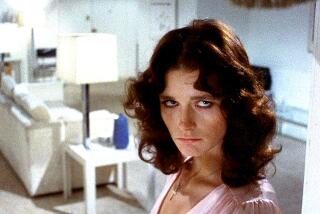Classic Hollywood: German emigres’ effect on U.S. cinema saluted
- Share via
The United States was a relatively provincial country in the 1930s, and the films coming out of Hollywood reflected this lack of sophistication, even though it was the glamorous center of the movie production world.
But the intellectual atmosphere began to percolate late in that decade with the arrival of German emigre writers, directors, producers, actors, composers and literati who had fled the Nazis.
“That influx of what was literally hundreds and hundreds of these middle-European intellectuals, it changed this town,” said Jan-Christopher Horak, director of the UCLA Film & Television Archive.
Their arrival, said Horak, “changed not just the film industry and the kind of films that were being made, it changed the intellectual life. You have people who are not in the film industry but came here because of the weather and perceived opportunities like [composer] Arnold Schoenberg and [author] Thomas Mann. They changed the intellectual character of Southern California.”
Horak noted that before the Nazis came into power in 1933, “the borders between Hollywood and Berlin were quite fluid. Ernst Lubitsch came in the ‘20s, but like a lot of them he didn’t necessarily come to live forever and ever in Los Angeles.” That changed once the Nazis took over. Now the exiles were here permanently.
That legacy is the subject of an upcoming “Light & Noir: Exiles and Emigres in Hollywood, 1933-1950” exhibition that opens at the Skirball Center on Oct. 23 as well as a new film series at the archive, “Exile Noir,” which opens Aug. 22.
The series kicks off quite appropriately at the Billy Wilder Theater with Wilder’s 1944 noir masterpiece “Double Indemnity” starring Barbara Stanwyck and Fred MacMurray as well as Andre de Toth’s 1948 “Pitfall” with Dick Powell.
Noted Horak: “I think you can make a definite case that noir has two sites of origin. The pulp fiction of Raymond Chandler and all of those writers of detective fiction, that is the American source. But in terms of visual language, I think you have to look much closer at the emigres and the infusion of German Expressionism and camera angles.”
Equally important, added Horak, is that these directors knew how to shoot on shoestring budgets for “poverty row” studios. Major studio directors would shoot a lot of coverage — long shots, master shots, close-ups — to give editors options. But these emigre directors “were used to doing it completely differently by only shooting what they needed.”
Arianne Ulmer Cipes, the daughter of European director Edgar G. Ulmer (“Detour”), said her father “picked scripts that could be directed for pennies,” she noted. Cipes will appear in person Sept. 26 when “Exile Noir” screens her father’s 1944 cult thriller “Bluebeard” starring John Carradine as a French puppeteer who murders women.
“He made it in 11 days,” said Cipes of “Bluebeard.”
The exile directors didn’t just shoot fast to cut costs. There was also a method to their madness.
“When Ulmer gets to do a film at Warner Bros., Jack Warner gets bent out of shape,” Horak said. “Ulmer is only shooting a minimum of footage so you could only edit it the way Ulmer wants to edit it. That’s a strategy that all of these European directors used to make sure the film they wanted to make got made.”
The subject matter of these noirs were dark, dangerous and psychologically complex. The traditional heroic protagonist has given away to troubled, angry, often violent men. Women were femme fatales out to conquer and destroy anyone who crossed them. These films, Horak said, reflected the hardships the emigres had endured.
“The directors, who are at the top of their game in Europe, suddenly are dirt poor, stateless, homeless,” Horak said. “They come to Hollywood and some of them — not all of them — managed to claw their way up again. Once you have lost everything — and if you are in the U.S. after the war hearing about all of your relatives who have been gassed — it changed your perspective. That profound experience changed their view of human nature, and that comes through in film noir.”
Though “Exile Noir” does features films from such well-known directors like Wilder, Otto Preminger (“Whirpool”) and Fritz Lang (“The Blue Gardenia”), the festival shines the spotlight on lesser-known emigre directors such as E.A. Dupont (“The Scarf”), Gustav Machaty (“Jealous”), John Reinhardt (“Chicago Calling”) and Curtis Bernhardt (“High Wall”).
“Exile Noir” also dovetails the UCLA’s archive’s “Hollywood Exiles in Europe” series, closing Sunday, which featured films written and directed by blacklisted writers and directors who were exiled in Europe. Several of these film noirs were written by blacklisted writers.
“A lot of these teams had worked together making anti-Nazi films,” Horak said. “For the blacklisted writers — most of whom were communists — making anti-Nazi films was finally a way to be overtly political and for the refugees, it was a way to finally fight back. So they were natural allies, and this continues after the war in other genres too.”
More to Read
Only good movies
Get the Indie Focus newsletter, Mark Olsen's weekly guide to the world of cinema.
You may occasionally receive promotional content from the Los Angeles Times.











